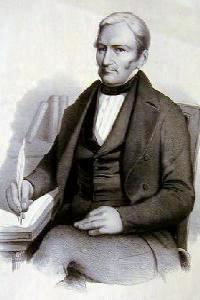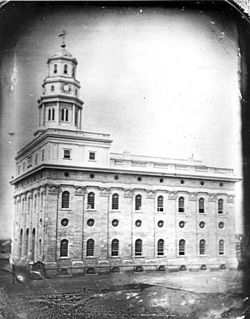
Hancock County is a county in the U.S. state of Illinois. According to the 2020 census, it has a population of 17,620. Its county seat is Carthage, and its largest city is Hamilton. The county is made up of rural towns with many farmers.

Carthage is a city and the county seat of Hancock County, Illinois, United States. The population was 2,490 as of the 2020 census, Carthage is best known for being the site of the 1844 death of Joseph Smith, founder of the Latter Day Saint movement.

Nauvoo is a small city in Hancock County, Illinois, United States, on the Mississippi River near Fort Madison, Iowa. The population of Nauvoo was 950 at the 2020 census. Nauvoo attracts visitors for its historic importance and its religious significance to members of several groups: The Church of Jesus Christ of Latter-day Saints; the Community of Christ, formerly the Reorganized Church of Jesus Christ of Latter Day Saints (RLDS); other groups stemming from the Latter Day Saint movement; and the Icarians. The city and its immediate surrounding area are listed on the National Register of Historic Places as the Nauvoo Historic District.

Western Illinois University (WIU) is a public university in Macomb, Illinois. It was founded in 1899 as Western Illinois State Normal School. As the normal school grew, it became Western Illinois State Teachers College.

The Icarians were a French-based utopian socialist movement, established by the followers of politician, journalist, and author Étienne Cabet. In an attempt to put his economic and social theories into practice, Cabet led his followers to the United States of America in 1848, where the Icarians established a series of egalitarian communes in the states of Texas, Illinois, Iowa, Missouri, and California. The movement split several times due to factional disagreements.

Étienne Cabet was a French philosopher and utopian socialist who founded the Icarian movement. Cabet became the most popular socialist advocate of his day, with a special appeal to artisans who were being undercut by factories. Cabet published Voyage en Icarie in French in 1839, in which he proposed replacing capitalist production with workers' cooperatives. Recurrent problems with French officials, led him to emigrate to the United States in 1848. Cabet founded utopian communities in Texas and Illinois, but was again undercut, this time by recurring feuds with his followers.

The Nauvoo Temple was the second temple constructed by the Church of Jesus Christ of Latter Day Saints. The church's first temple was completed in Kirtland, Ohio, United States, in 1836. When the main body of the church was forced out of Nauvoo, Illinois, in the winter of 1846, the church attempted to sell the building, finally succeeding in 1848. The building was damaged by fire and a tornado before being demolished.
William Weeks, was the first church architect of the Church of Jesus Christ of Latter Day Saints, and is best known as the architect of the Nauvoo Temple.

The Benjaminville Friends Meeting House and Burial Ground is a Friends Meeting House of the Religious Society of Friends (Quakers), located north of the rural village of Holder in McLean County, Illinois. It was once the site of a now-defunct village called Benjaminville, founded in 1856 after Quakers settled the area. More Quakers followed, and the burial ground, then the current meeting house in 1874, were constructed. This site, listed on the U.S. National Register of Historic Places since 1983, is all that remains of that village.

A round barn is a historic barn design that could be octagonal, polygonal, or circular in plan. Though round barns were not as popular as some other barn designs, their unique shape makes them noticeable. The years from 1880 to 1920 represent the height of round barn construction. Round barn construction in the United States can be divided into two overlapping eras. The first, the octagonal era, spanned from 1850 to 1900. The second, the true circular era, spanned from 1889 to 1936. The overlap meant that round barns of both types, polygonal and circular, were built during the latter part of the nineteenth century. Numerous round barns in the United States are listed on the National Register of Historic Places.

The Plano Stone Church was constructed in 1868 to serve as the headquarters for the Reorganized Church of Jesus Christ of Latter Day Saints under the leadership of Joseph Smith III. Smith moved to Plano, Illinois, in 1866 and in 1867 was appointed head of the Stone Church's building committee. Smith and the committee selected the site, design and builder for the structure. The Plano Stone Church served as the headquarters of the RLDS from its completion in 1868 until Smith, his family, and the church moved to Lamoni, Iowa, in 1881.

Nauvoo Historic District is a National Historic Landmark District containing the city of Nauvoo, Illinois. The historic district is nearly coterminous with the City of Nauvoo as it was incorporated in 1840, but it also includes the Pioneer Saints Cemetery, the oldest Mormon cemetery in the area, which is outside the town boundary.
The history of Nauvoo, Illinois, starts with the Sauk and Fox tribes who frequented the area. They called the area "Quashquema", named in honor of the Native American chief who headed a Sauk and Fox settlement numbering nearly 500 lodges. Permanent settlement by non-natives was reportedly begun in 1824 by Captain James White. By 1827 other white settlers had built cabins in the area. By 1829 this area of Hancock County had grown sufficiently so that a post office was needed, and in 1832 the town, now called "Venus", was one of the contenders for the new county seat. However, the nearby city of Carthage was selected instead. In 1834 the name Venus was changed to "Commerce" because the settlers felt that the new name better suited their plans. In late 1839, arriving Mormons bought the small town of Commerce, and in April 1840 it was renamed "Nauvoo" by Joseph Smith, the leader and prophet of the Latter Day Saint movement. Nauvoo grew rapidly and for a few years was one of the most populous cities in Illinois. Within two years of Joseph Smith's killing by a mob in 1844, most of the population had departed, fleeing armed violence. Most headed west with the group led by Brigham Young.

Cheltenham is a neighborhood of St. Louis, Missouri. It is bound by Forest Park on the north, Macklind on the east, Manchester Avenue on the south, and Hampton Avenue on the west. Businesses located in Cheltenham include the St. Louis Community College at Forest Park, which is built on the site of the former Forest Park Highlands amusement park, as well as The Green Shag Market vintage/antique mall. It is also the former home of FOX-affiliate KTVI, as well as the St. Louis Arena. Cheltenham once covered the Clayton-Tamm neighborhood. See the 1878 Cheltenham and Additions map.

The Brigham Young Winter Home and Office is a historic residence and museum located in St. George, Utah. Brigham Young was the foremost Mormon pioneer and second president of The Church of Jesus Christ of Latter-day Saints, who led its members to the Utah Territory. As Young grew older, his arthritis precluded him from spending winters in the Salt Lake City region, so a winter home in St. George, in the arid Dixie region of Utah, was built for him. Young seasonally occupied the home and office from 1873 to 1876. The building was eventually deeded to the division of Utah State Parks and Recreation; it is now open as a museum where missionaries of the Church provide guided tours.

The Peter Wentz House is a historic building located in northern downtown Provo, Utah, United States. It is listed on the National Register of Historic Places.

The Adlai E. Stevenson II Farm, also known as Adlai E. Stevenson Historic Home is a historic property located on St. Mary's Road in Mettawa, Illinois. Between 1936 and his death it was the home of Adlai Stevenson II (1900-1965), a Democratic politician who was the governor of Illinois between 1949 and 1953, was twice the Democratic Party's presidential candidate in the 1952 and 1956 elections, and was a candidate for the Democratic presidential nomination again in 1960, losing to Senator John F. Kennedy. Stevenson served as the US Ambassador to the United Nations from 1961 until his death in July 1965. He was America's UN Ambassador during the Cuban Missile Crisis in October 1962. The farm was listed on the National Register of Historic Places and has also been designated a National Historic Landmark. The property is located in the northern suburbs of Chicago, in the Captain Daniel Wright Woods Forest Preserve. It currently functions as a museum.

The William J. Reimbold House is a historic house located at 950 White Street in Nauvoo, Illinois. The house was built in 1865-67 for William and Christian Reimbold, who were part of a wave of German immigrants who settled in Nauvoo in the 1860s and 1870s. After the Mormons and Icarians left the city, the immigrants bought up the vacated land at low prices and were largely responsible for the city's continued development. The Reimbolds were part of the city's winemaking industry, one of the most significant parts of the city economy formed by the immigrants; their stone wine cellar still stands on their property. The Reimbold House is one of two German immigrant homes, and the only one with an intact wine cellar, remaining in Nauvoo's Mormon Flat district, as the rest were destroyed during a period of Mormon restoration in the twentieth century.

The Carthage Courthouse Square Historic District is a historic district encompassing the courthouse square of Carthage, Hancock County, Illinois. The district includes 52 buildings, 42 of which are considered contributing to the district's historic character. The 1908 Hancock County Courthouse, a three-story limestone Beaux-Arts building, is the centerpiece of the district. The courthouse is surrounded by commercial buildings, most of them built in the latter half of the nineteenth century. Architect George Payne designed many of the district's commercial buildings, giving him a reputation which spread beyond Carthage; his works include Italianate and Romanesque Revival designs.

The Hunziker Winery Site is the site of a former winery in Cedar Glen State Natural Area near Warsaw, Illinois. The winery was established in the 1860s by vintner and Swiss immigrant Gottlieb Hunziker and his business partner William Hoffman. At the time, Hancock County was becoming a major winemaking region, and the Warsaw area was second only to Nauvoo as a wine center within the county. Hunziker's wine was well-regarded among his contemporaries, as he won multiple awards at the 1870 Iowa State Fair, held across the Mississippi River in Keokuk. Hunziker continued to produce wine until his death in 1893. The remains of the winery include the walls of its wine house, in which grapes were processed and fermented, and an underground wine cellar.



















